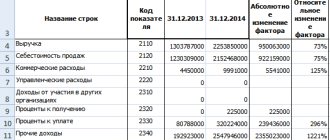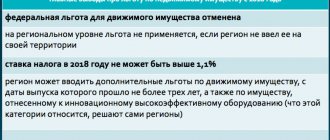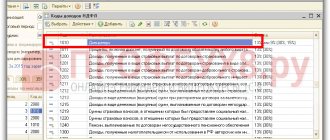Who pays property tax
Russian organizations are required to pay tax if four conditions are simultaneously met:
- there is real estate on the balance sheet (including those transferred for temporary possession, use, disposal, trust management, contributed to joint activities, received under a concession agreement);
- this property is accounted for on the balance sheet as a fixed asset in accounts 01 “Fixed Assets” or 03 “Income Investments in Material Assets”;
- existing property is recognized as an object of taxation on the grounds specified in Art. 374 Tax Code of the Russian Federation;
- the tax base for such real estate is determined as the average annual value.
Also, property tax is paid on real estate located in the Russian Federation and, as a general rule, owned by an organization, obtained under a concession agreement, if the tax base for it is the cadastral value.
Please note that from 2021 the movable property tax has been abolished!
Enterprises will not have to pay tax on land plots, water and cultural objects, as well as on other types of property named in paragraph 4 of Art. 374 Tax Code of the Russian Federation.
A number of organizations, depending on the type of activity, are not charged tax (Article 381 of the Tax Code of the Russian Federation).
Fill out and send reports to the Federal Tax Service on time and without errors with Kontur.Extern. 3 months of service are free for you!
Try it
Tax calculation based on average annual cost
In turn, the average annual value = (total residual value of the property as of the 1st day of each month + residual value as of December 31) / 13.
Calculation example. Kompas LLC has been on the services market for 8 years. During this time, the Company purchased various fixed assets that help carry out its activities. Some of the property is still depreciated and considered taxable. In addition, the company purchased new equipment on July 4, 2020. The region applies a rate of 2.2%. The accountant, filling out the declaration for the past year, used the following data:
| As of: | Residual value, thousand rubles. |
| 01.01.19 | 100 |
| 01.02.19 | 95 |
| 01.03.19 | 90 |
| 01.04.19 | 85 |
| 01.05.19 | 80 |
| 01.06.19 | 75 |
| 01.07.19 | 70 |
| 01.08.19 | 234 |
| 01.09.19 | 207 |
| 01.10.19 | 191 |
| 01.11.19 | 174 |
| 01.12.19 | 146 |
| 31.12.19 | 118 |
Let's calculate the average annual cost: (100 + 95 + 90 + 85 + 80 + 75 +70 + 234 + 207 +191 + 174 + 146 + 118) / 13 x 1000 = 128,077 rubles.
Tax payable for the year = 128,077 x 2.2% = 2,818 rubles. (provided that the organization does not pay advances).
If advance payments are established in the region, organizations need to pay them three times a year, and then reduce the tax payable for the year by their amounts.
Let us assume that in the proposed example, in addition to tax, it is required to calculate the amount of the advance for all reporting periods.
Average cost of taxable objects for the first quarter = (100 + 95 + 90 + 85) / 4 x 1000 = 92,500 rubles.
According to Art. 382 of the Tax Code of the Russian Federation, the advance payment is equal to ¼ of the average cost for the reporting period, multiplied by the rate.
Advance payment for the first quarter = 92,500 x ¼ x 2.2% = 509 rubles.
The half-year payment is calculated in the same way.
Average cost for half a year = (100 + 95 + 90 + 85 + 80 + 75 + 70) / 7 x 1,000 = 85,000 rubles.
Advance for half a year = 85,000 x ¼ x 2.2% = 468 rubles.
Average cost for 9 months = (100 + 95 + 90 + 85 + 80 + 75 + 70 + 234 + 207 +191) / 10 x 1,000 = 122,700 rubles.
Advance for 9 months = 122,700 x ¼ x 2.2% = 675 rubles.
The annual tax is paid minus any advance payments.
Tax for 2021 payable to the budget = 2,818 – (509 + 468 + 675) = 1,166 rubles.
Tax calculation based on cadastral value
The tax base for a certain part of real estate corresponds to the cadastral value indicated in the Unified State Register as of January 1 (Article 375 of the Tax Code of the Russian Federation). This includes real estate from clause 1 of Art. 378.2 Tax Code of the Russian Federation.
If a company pays tax based on cadastral value, then you must first find it out in the regional office of Rosreestr or in an extract from the Unified State Register of Real Estate. You can also view the cost online on the Rosreestr website or in the regulatory act of your region, which approved the results of determining the cadastral value. If your property is included in the regional list, but the cadastral value for it has not been established, you do not need to pay tax. However, residential premises, garages, unfinished construction and other objects from paragraphs. 4 paragraphs 1 art. 378.2 of the Tax Code of the Russian Federation, is not indicated in regional lists. The tax on them is paid on the basis of regional law, which should provide for cadastral taxation of these objects. If the cadastral value for them has not been determined, calculate the tax at the average annual value.
Formula for calculating tax based on cadastral value:
Tax amount for the year = Cadastral value × 2.2% - advance payments.
Advance payment = Cadastral value of the property as of January 1 × 2.2% × ¼.
Calculation example . PlusMinus LLC owns an office in the business center. The cadastral value of the premises has not been determined, but it is known that it occupies 1/16 of the building’s area. According to Rosreestr, the cadastral value of the business center is 184 million rubles.
Cadastral value of the office = 184 million rubles / 16 = 11.5 million rubles.
Tax amount for the year = 11.5 million rubles × 2.2% = 253,000 rubles.
Advance payments will be = 253,000 / 4 = 63,250 rubles per quarter.
Tax rates
Since the deduction is local in nature, the size of the rates is set according to the decisions of the authorities of each subject of the country, but guided by the rules common to all territories. Anyone can read more about determining the base on the pages of the Tax Code of the Russian Federation.
Previously, the inventory price was used as the basis for calculating contributions to the Russian budget by individuals, but today there is a widespread transition to the price from the country’s unified cadastre, which differs significantly from the first type in that it is as close as possible to the market price.
The bet size cannot exceed:
- 2%;
- 0,5%;
- 0,1%.
2% is established for all property objects whose price is more than 3,000,000 rubles, and in addition for the list of items from Article No. 378.2 of the Tax Code of the Russian Federation.
The 0.1% tax is valid for:
- residential buildings;
- rooms in apartment buildings;
- places where vehicles are kept and stored;
- unfinished buildings designed for the purpose of constructing a residential building;
- real estate complexes of a single building, inside of which there is at least one premises intended for living;
- garages;
- erected structures suitable for carrying out economic work, the size of which in general does not exceed 50 meters square, and located on land plots used for vegetable gardening, gardening work, residential construction, and subsidiary farming.
Subjects of the Russian Federation can reduce or increase the rate independently. The maximum magnification size is three times. 0.5% is used for property not listed in the previous paragraphs.
If the regulations issued by the authorities do not specify the established rate, it can be differentiated based on:
- cadastral prices;
- type of taxable object;
- territorial location;
- the varieties of places within whose boundaries its location lies.
For those municipalities where the old format, inventory price is still taken as the base, the tax rates will be as follows.
Option 1. If their value is determined only in the form of a derivative with a deflator-coefficient applied to the total price of taxable contributions to the state of items owned by a resident of the Russian Federation , then the standards presented in the table apply.
Table 1. Contribution standards
| Object price | Bet size |
| Less than three hundred thousand rubles | One tenth of a percent, including the indicated value |
| From three to five hundred thousand rubles | From one tenth to three tenths of a percent, taking into account the indicated value |
| More than half a million rubles | From three tenths to two whole percent |
Option 2. If the rates are not established in the regulations of the territory’s legal acts, then deductions will be made at a tenth of a percent for objects whose value is calculated as an inventory value multiplied by a deflator coefficient, up to an amount of half a million rubles and for other property objects at three tenths of a percent.
You can differentiate rates according to:
- the total price of the nature of the inventory;
- types of taxable denomination;
- its location;
- types of territories within the boundaries of which real estate is located.
Procedure and deadlines for tax payment
The tax period is a calendar year (Article 379 of the Tax Code of the Russian Federation).
The reporting period is 1 year. Previously, advance payments had to be submitted every quarter. Now they have been included in the declaration, so there is no need to report separately. The last report on advances was submitted for 9 months of 2021.
At the end of the year, property taxes are paid, and at the end of quarters, advance payments are paid. Regional authorities may decide not to establish advance payments, in which case the tax will only have to be paid once a year.
The deadlines for payment are also set by the constituent entities of the Russian Federation (Article 383 of the Tax Code of the Russian Federation).
Features of tax payment
Article No. 382 of the Tax Code of the Russian Federation states that for various organizations such a form of payment is provided as repayment of advance payments. If you calculate the tax amount, it will be equal to the difference in certain indicators, for the calculation of which a general formula is taken.
When calculating the advance payment, it is necessary to take into account that this indicator is 1/4 of the tax rate and the price of the property in the reporting period. The payment can be calculated in several ways, the main condition being compliance with the requirements of current legislation.
Important! To correctly perform the calculation, it is recommended to draw up a table of all residual price amounts individually for each property.
The deadline for submitting (paying) the tax is regulated by regional legislation, for example, according to the example discussed above, the enterprise must make quarterly payments, and the total amount of payments corresponds to the values specified earlier.
Conclusion
Calculating tax on property assets of legal organizations is a rather complex and labor-intensive process that takes a lot of time and requires special attention. Such calculations should only be carried out by a competent specialist so that problematic issues do not arise later.
Important! Compliance with the established procedure by law when performing property tax calculations for legal organizations. To correctly and competently perform settlement operations, it is recommended to compile summary tables, monitor, and thoroughly analyze the necessary data for calculations.
Property tax declaration
Please note that by Order of the Federal Tax Service dated August 14, 2019 No. SA-7-21/ [email protected] as amended on July 28, 2020, a new form of property tax declaration for 2021 was approved. The order comes into force on November 3, 2020. Based on the results of 2021 (before April 1, 2021), you already need to report using the new form.
Rules for filling out a declaration with line-by-line comments from the appendix to the Order of the Federal Tax Service of the Russian Federation dated August 14, 2019 No. SA-7-21/ [email protected]
In the first section, line 005 “Taxpayer Attribute” was added, which is related to coronavirus benefits, and line 007 “SZPK Attribute” for organizations that have entered into an agreement on the protection and promotion of capital investments. For section two, new codes for coronavirus federal and regional benefits were approved, as well as a special code for the property of FEZ participants.
The most important innovation is the appearance of the fourth section, in which organizations will again have to reflect information on the average annual value of movable property recorded on the balance sheet as fixed assets (it is still not subject to tax). The amendments are being made to assess the value of movable property, which is currently exempt from tax. It is planned that taxation of movable property will return in the near future, but tax rates will be reduced.
Where to get basic data to calculate the tax amount
Art. 17 of the Tax Code of the Russian Federation requires, when introducing a tax, to establish taxation rules. It is necessary to determine:
- taxpayers;
- object of taxation;
- tax base;
- taxable period;
- tax rate;
- calculation order.
These characteristics are indicated in the second part of the Tax Code of the Russian Federation. There is a separate chapter for each tax.
Benefits may also be established by law. Those established at the federal level are indicated in the chapter of the Tax Code of the Russian Federation dedicated to each tax. Regional and local authorities can establish their own benefits. Information on the availability and nature of local and regional benefits can be obtained from the legislative acts of the relevant authorities. The Federal Tax Service (FTS) provides the opportunity to obtain information about the availability of benefits on its website.







